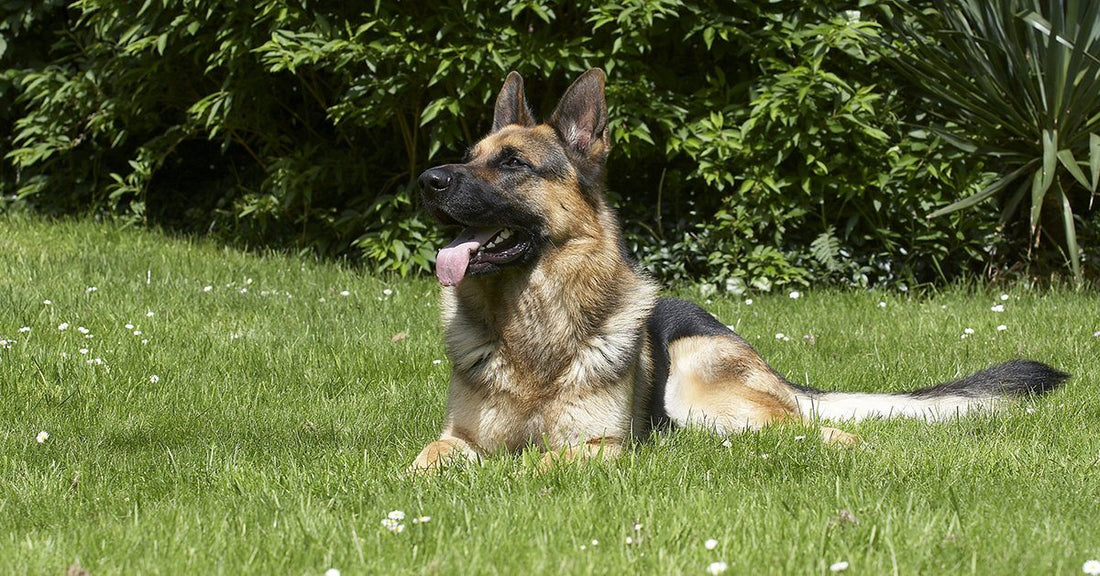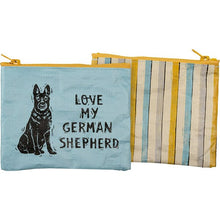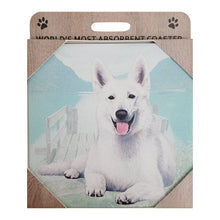29 Essential Training Commands To Teach Your German Shepherd

Teaching your German shepherd essential commands is important to their safety and well-being. Along with a healthy diet, exercise, socialization, and routine veterinary care, it’s one of the most important aspects of dog ownership.
A dog that is well trained is a pleasure to live with and also safer in your home and while out in the community. Along with helping your dog be more manageable, and teaching them how to behave in all environments, dog training is also fun and provides hours of mental stimulation for intelligent dogs, like German shepherds.
How many commands you teach your German shepherd is up to you but most of them can easily learn all 29 on this list:
1. Sit
Teaching your dog to sit on command is useful throughout their life. It’s a go to command that dogs need to learn and practice in all environments. Teaching your dog to sit is also very helpful when trying to calm an excited dog or when meeting new people.
2. Watch me
Teaching the watch me command is useful in getting your dog’s attention. By teaching them the watch me command, you’ll be able to get their attention in an emergency or when there are lots of distractions. It’s also useful to use before giving another command or when teaching your dog hand signals.

3. Come
Teaching the come or recall command is a very basic, potentially lifesaving, must do. All dogs need to learn that the word come means that they stop what they are doing and come back to you. Before taking your dog off leash, or into areas with lots of distractions, they should master the come command. It’s also very useful should your dog escape their leash, jump out of the car, or accidently get out of the house or yard.
4. Wait
Wait is a useful command to teach because it teaches your dog to pause and wait for directions and get permission from you. Use wait before walking out the door, getting in or out of the car, greeting guests, at mealtimes, the list is endless.
5. Stay
Teaching a dog to stay is one of the most important commands they can learn. This command should be reinforced throughout their lifetime, in case you ever need it in an emergency. Dogs should also learn to be released from all commands and this will help reinforce that when practicing their training.

6. Break or release
This command is used to release your dog from their sit, stay, down, or other commands.
7. Down
Teaching the down or belly on the floor command is another go-to and should be started in puppyhood. This command is very useful in many situations but one important place is at the vet, during an exam or nail trimming. The down command is also great for getting control over an overly stimulated dog.

8. Stand
Use this command when you want your dog to stand up on all four paws from a down or a sit. This command is helpful when you want your dog to hold still to be handled, groomed, or for an exam at the vet.
9. Off
The off command is used to teach a dog to remove their paws off something, such as a person or furniture. It is important to be consistent when teaching this command so that the dog doesn’t get confused about what is and is not okay to jump on.

10. No
Just like kids, dogs need to be taught that no means no for their own safety and your sanity. No can be used to stop your dog from doing something you don’t want them to do like chewing furniture, puppy biting, sniffing something you don’t want them to sniff, or to stop them from picking something up to eat it. No is used to stop them from taking unwanted action.
11. Leave it
Similar and often interchanged with no, the leave it command is used to teach your dog to leave something alone. Dogs should learn that they should not pick something up off the ground and eat it or stick their nose somewhere they shouldn’t by using this important command.
12. Take it
This command is used to teach your dog when it’s okay to take something. Taught in conjunction with the leave it command, the command helps teach impulse control and also teaches them to look to you for permission to take something.
13. Drop it
Next comes the drop it command. In case your dog doesn’t leave it, they need to learn to drop it. By teaching your dog to drop something, you will help protect their health and your valuables.

14. Heel
Teaching your dog to heel, or properly walk on a leash, is a vital command for all German shepherds to learn. Your dog should learn that it’s never okay to drag you down the street and lunge and pull at the end of their leash. They need to learn how to walk anywhere politely.
15. Leash
Along with heel, it’s helpful to teach your dog the word leash. Leash means, let’s pause and calmly untangle you from your leash.
16. Here
Here means come and stand in front of me or at my side. This is a great obedience command to use to begin an off-leash heel, when putting on a leash, or to get your dog next to you.
17. Take care of business
You can use whatever command you choose for going outside to take care of business (go pee and pooh), just be consistent with the word you choose.

18. Place
Teaching your dog to place, or go to a designated place in the house such as their bed, is very important and a lifesaver when you need them out of the way so that you can easily get them out of the kitchen, away from a mess, to calm them down, or remove them from a situation.
19. Load up or car
Teaching your dog when it’s time to load up or get in the car is a great way to set the expectation that you’re going somewhere together. It is also useful in teaching them how you want them to get physically get into the car.

20. Back up
Teaching your dog to back up is fun and also helpful when you need them to move out of the way by backing up.
21. Stop
Teaching your dog to stop teaches them to immediately stop what they are doing and stand still. This is a great command to improve impulse control but is also useful in many situations, including emergencies and when playing games.
22. Yes or good dog
Teaching this command lets your dog know that they’ve done something right.
23. Kennel up
If your dog is crate trained, use this command to send them to their crate.
24. Roll over
Roll over can be used for more than a cute trick. It can be useful when grooming, looking your dog over, or at the vet.
25. Go eat
By giving your dog permission to go eat, you help prevent them from going after their food before the bowl is on the floor, and they also learn to wait for permission to eat so it helps improve impulse control.

26. Go in
Teaching your dog that go in means it’s time to go in from outside or enter a room is helpful and fun. It communicates exactly what you expect from your dog and is especially handy when traveling or staying at new places.
27. Go out
Teaching the opposite, go out from a room is also great for setting expectations and communicating exactly what you want your dog to do.
28. Quiet
Teaching the quiet command teaches your dog that they need to be quiet and stop barking. This command is great for many reasons but especially when traveling or when they are barking and you need them to hush.

29. Speak
The opposite of quiet, teaching your dog to speak actually reinforces the quiet command because the dog learns both. Teaching your dog to bark on command is fun and also can be useful, for example if you want to warn someone that a dog is nearby.
You may also like: How To Train Your Dog With A Clicker
























